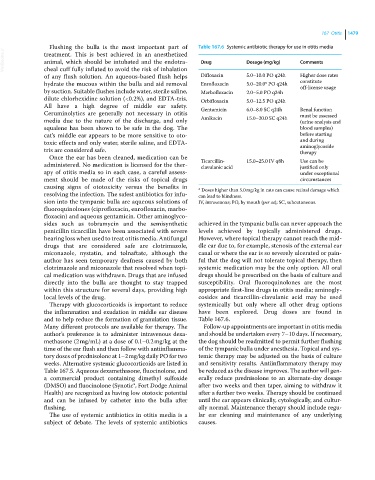Page 1541 - Clinical Small Animal Internal Medicine
P. 1541
167 Otitis 1479
Flushing the bulla is the most important part of Table 167.6 Systemic antibiotic therapy for use in otitis media
VetBooks.ir treatment. This is best achieved in an anesthetized Drug Dosage (mg/kg) Comments
animal, which should be intubated and the endotra-
cheal cuff fully inflated to avoid the risk of inhalation
of any flush solution. An aqueous‐based flush helps Difloxacin 5.0–10.0 PO q24h Higher dose rates
hydrate the mucous within the bulla and aid removal Enrofloxacin 5.0–20.0* PO q24h constitute
off‐license usage
by suction. Suitable flushes include water, sterile saline, Marbofloxacin 2.0–5.0 PO q24h
dilute chlorhexidine solution (<0.2%), and EDTA‐tris. Orbifloxacin 5.0–12.5 PO q24h
All have a high degree of middle ear safety. Gentamicin 6.0–8.0 SC q24h Renal function
Ceruminolytics are generally not necessary in otitis must be assessed
media due to the nature of the discharge, and only Amikacin 15.0–20.0 SC q24h (urine analysis and
squalene has been shown to be safe in the dog. The blood samples)
cat’s middle ear appears to be more sensitive to oto- before starting
toxic effects and only water, sterile saline, and EDTA‐ and during
aminoglycoside
tris are considered safe. therapy
Once the ear has been cleaned, medication can be
administered. No medication is licensed for the ther- Ticarcillin‐ 15.0–25.0 IV q8h Use can be
justified only
clavulanic acid
apy of otitis media so in each case, a careful assess- under exceptional
ment should be made of the risks of topical drugs circumstances
causing signs of ototoxicity versus the benefits in * Doses higher than 5.0 mg/kg in cats can cause retinal damage which
resolving the infection. The safest antibiotics for infu- can lead to blindness.
sion into the tympanic bulla are aqueous solutions of IV, intravenous; PO, by mouth (per os); SC, subcutaneous.
fluoroquinolones (ciprofloxacin, enrofloxacin, marbo-
floxacin) and aqueous gentamicin. Other aminoglyco-
sides such as tobramycin and the semisynthetic achieved in the tympanic bulla can never approach the
penicillin ticarcillin have been associated with severe levels achieved by topically administered drugs.
hearing loss when used to treat otitis media. Antifungal However, where topical therapy cannot reach the mid-
drugs that are considered safe are clotrimazole, dle ear due to, for example, stenosis of the external ear
miconazole, nystatin, and tolnaftate, although the canal or where the ear is so severely ulcerated or pain-
author has seen temporary deafness caused by both ful that the dog will not tolerate topical therapy, then
clotrimazole and miconazole that resolved when topi- systemic medication may be the only option. All oral
cal medication was withdrawn. Drugs that are infused drugs should be prescribed on the basis of culture and
directly into the bulla are thought to stay trapped susceptibility. Oral fluoroquinolones are the most
within this structure for several days, providing high appropriate first‐line drugs in otitis media; aminogly-
local levels of the drug. cosides and ticarcillin‐clavulanic acid may be used
Therapy with glucocorticoids is important to reduce systemically but only where all other drug options
the inflammation and exudation in middle ear disease have been explored. Drug doses are found in
and to help reduce the formation of granulation tissue. Table 167.6.
Many different protocols are available for therapy. The Follow‐up appointments are important in otitis media
author’s preference is to administer intravenous dexa- and should be undertaken every 7–10 days. If necessary,
methasone (2 mg/mL) at a dose of 0.1–0.2 mg/kg at the the dog should be readmitted to permit further flushing
time of the ear flush and then follow with antiinflamma- of the tympanic bulla under anesthesia. Topical and sys-
tory doses of prednisolone at 1–2 mg/kg daily PO for two temic therapy may be adjusted on the basis of culture
weeks. Alternative systemic glucocorticoids are listed in and sensitivity results. Antiinflammatory therapy may
Table 167.5. Aqueous dexamethasone, fluocinolone, and be reduced as the disease improves. The author will gen-
a commercial product containing dimethyl sulfoxide erally reduce prednisolone to an alternate‐day dosage
(DMSO) and fluocinolone (Synotic®, Fort Dodge Animal after two weeks and then taper, aiming to withdraw it
Health) are recognized as having low ototoxic potential after a further two weeks. Therapy should be continued
and can be infused by catheter into the bulla after until the ear appears clinically, cytologically, and cultur-
flushing. ally normal. Maintenance therapy should include regu-
The use of systemic antibiotics in otitis media is a lar ear cleaning and maintenance of any underlying
subject of debate. The levels of systemic antibiotics causes.

